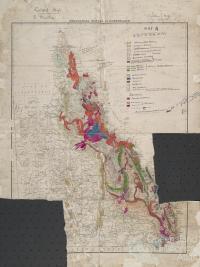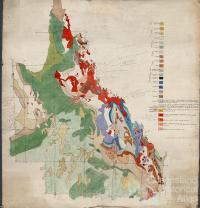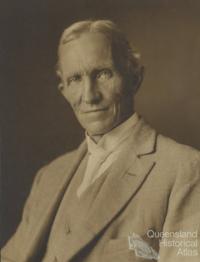- Home
- Quintessential Queensland
- Distinctiveness
- Perceptions
- Perceptions: how people understand the landscape
- From runs to closer settlement
- Geological survey of Queensland
- Mapping a new colony, 1860-80
- Mapping the Torres Strait: from TI to Magani Malu and Zenadh Kes
- Order in Paradise: a colonial gold field
- Queensland atlas, 1865
- Queensland mapping since 1900
- Queensland: the slogan state
- Rainforests of North Queensland
- Walkabout
- Queenslanders
- Queenslanders: people in the landscape
- Aboriginal heroes: episodes in the colonial landscape
- Australian South Sea Islanders
- Cane fields and solidarity in the multiethnic north
- Chinatowns
- Colonial immigration to Queensland
- Greek Cafés in the landscape of Queensland
- Hispanics and human rights in Queensland’s public spaces
- Italians in north Queensland
- Lebanese in rural Queensland
- Queensland clothing
- Queensland for ‘the best kind of population, primary producers’
- Too remote, too primitive and too expensive: Scandinavian settlers in colonial Queensland
- Distance
- Movement
- Movement: how people move through the landscape
- Air travel in Queensland
- Bicycling through Brisbane, 1896
- Cobb & Co
- Journey to Hayman Island, 1938
- Law and story-strings
- Mobile kids: children’s explorations of Cherbourg
- Movable heritage of North Queensland
- Passages to India: military linkages with Queensland
- The Queen in Queensland, 1954
- Transient Chinese in colonial Queensland
- Travelling times by rail
- Pathways
- Pathways: how things move through the landscape and where they are made
- Aboriginal dreaming paths and trading ways
- Chinese traders in the nineteenth century
- Introducing the cane toad
- Pituri bag
- Press and the media
- Radio in Queensland
- Red Cross Society and World War I in Queensland
- The telephone in Queensland
- Where did the trams go?
- ‘A little bit of love for me and a murder for my old man’: the Queensland Bush Book Club
- Movement
- Division
- Separation
- Separation: divisions in the landscape
- Asylums in the landscape
- Brisbane River
- Changing landscape of radicalism
- Civil government boundaries
- Convict Brisbane
- Dividing Queensland - Pauline Hanson’s One Nation Party
- High water mark: the shifting electoral landscape 2001-12
- Hospitals in the landscape
- Indigenous health
- Palm Island
- Secession movements
- Separate spheres: gender and dress codes
- Separating land, separating culture
- Stone walls do a prison make: law on the landscape
- The 1967 Referendum – the State comes together?
- Utopian communities
- Whiteness in the tropics
- Conflict
- Conflict: how people contest the landscape
- A tale of two elections – One Nation and political protest
- Battle of Brisbane – Australian masculinity under threat
- Dangerous spaces - youth politics in Brisbane, 1960s-70s
- Fortress Queensland 1942-45
- Grassy hills: colonial defence and coastal forts
- Great Shearers’ Strike of 1891
- Iwasaki project
- Johannes Bjelke-Petersen: straddling a barbed wire fence
- Mount Etna: Queensland's longest environmental conflict
- Native Police
- Skyrail Cairns (Research notes)
- Staunch but conservative – the trade union movement in Rockhampton
- The Chinese question
- Thomas Wentworth Wills and Cullin-la-ringo Station
- Separation
- Dreaming
- Imagination
- Imagination: how people have imagined Queensland
- Brisbane River and Moreton Bay: Thomas Welsby
- Changing views of the Glasshouse Mountains
- Imagining Queensland in film and television production
- Jacaranda
- Literary mapping of Brisbane in the 1990s
- Looking at Mount Coot-tha
- Mapping the Macqueen farm
- Mapping the mythic: Hugh Sawrey's ‘outback’
- People’s Republic of Woodford
- Poinsettia city: Brisbane’s flower
- The Pineapple Girl
- The writers of Tamborine Mountain
- Vance and Nettie Palmer
- Memory
- Memory: how people remember the landscape
- Anna Wickham: the memory of a moment
- Berajondo and Mill Point: remembering place and landscape
- Cemeteries in the landscape
- Landscapes of memory: Tjapukai Dance Theatre and Laura Festival
- Monuments and memory: T.J. Byrnes and T.J. Ryan
- Out where the dead towns lie
- Queensland in miniature: the Brisbane Exhibition
- Roadside ++++ memorials
- Shipwrecks as graves
- The Dame in the tropics: Nellie Melba
- Tinnenburra
- Vanished heritage
- War memorials
- Curiosity
- Curiosity: knowledge through the landscape
- A playground for science: Great Barrier Reef
- Duboisia hopwoodii: a colonial curiosity
- Great Artesian Basin: water from deeper down
- In search of Landsborough
- James Cook’s hundred days in Queensland
- Mutual curiosity – Aboriginal people and explorers
- Queensland Acclimatisation Society
- Queensland’s own sea monster: a curious tale of loss and regret
- St Lucia: degrees of landscape
- Townsville’s Mount St John Zoo
- Imagination
- Development
- Exploitation
- Transformation
- Transformation: how the landscape has changed and been modified
- Cultivation
- Empire and agribusiness: the Australian Mercantile Land and Finance Company
- Gold
- Kill, cure, or strangle: Atherton Tablelands
- National parks in Queensland
- Pastoralism 1860s–1915
- Prickly pear
- Repurchasing estates: the transformation of Durundur
- Soil
- Sugar
- Sunshine Coast
- The Brigalow
- Walter Reid Cultural Centre, Rockhampton: back again
- Survival
- Survival: how the landscape impacts on people
- Brisbane floods: 1893 to the summer of sorrow
- City of the Damned: how the media embraced the Brisbane floods
- Depression era
- Did Clem Jones save Brisbane from flood?
- Droughts and floods and rail
- Missions and reserves
- Queensland British Food Corporation
- Rockhampton’s great flood of 1918
- Station homesteads
- Tropical cyclones
- Wreck of the Quetta
- Pleasure
- Pleasure: how people enjoy the landscape
- Bushwalking in Queensland
- Cherbourg that’s my home: celebrating landscape through song
- Creating rural attractions
- Festivals
- Queer pleasure: masculinity, male homosexuality and public space
- Railway refreshment rooms
- Regional cinema
- Schoolies week: a festival of misrule
- The sporting landscape
- Visiting the Great Barrier Reef
By:
Paul Blake The 1928-29 map ‘Preliminary plot of Queensland section of Geological map of the Commonwealth of Australia’ is a good illustration of the state of the technology of map creation at the time that it was drawn. In the early part of the twentieth century it was common for the geologists to record their observations on a base such as a cadastral or topographic map, and after gathering enough information they would attempt to put boundaries around geological units. Eventually this compilation map would be passed onto a professional cartographer to create the geological map.
The exact history of this map is uncertain. However, from studying Queensland Government reports from this time, looking at older maps, as well as the completed map of the Geology of the Commonwealth of Australia, published by Edgeworth David in 1931, we can piece together why this map was most probably made.
In 1928 Edgeworth David embarked on an ambitious scheme to compile a geological map of the Commonwealth of Australia, which would become the most detailed geology map in the world for the scale that it was printed. No one person could know the geology of the whole of Australia, but fortunately, all of the states had Geological Surveys. The main aims of the Geological Surveys at that time were to evaluate mineral fields to ensure the economic viability of their states, but they also mapped the geology as they conducted their work. Therefore, Edgeworth David contacted Benjamin Dunstan, who was the Chief Government Geologist in Queensland at that time.
Dunstan and several other state geologists pooled their knowledge and sent Edgeworth David their interpretation of the geology of Queensland, which David added to his compilation map. The geological interpretation that Dunstan forwarded, and which is probably depicted in this map, was very similar to the 1905 Geological Sketch Map of Queensland, though there were some improvements made in areas where the Geological Survey had been working, such as around the Gympie Goldfields and the Permian Bowen Basin. We believe that the map sent by Dunstan to David is the map ‘The Geological survey of Queensland, 1928-29’. Just below the legend, written in pencil is a note that the map “is largely based on the Geol Sketch map of Qland (B. Dunstan) 1905 but chief alterations refer to” and then lists the areas that have been improved since 1905.
Compiling the data probably highlighted to Dunstan that the 1905 Geological Sketch Map of Queensland was out-of-date and he assigned J.H. Reid to begin compiling a new map. Much of 1928 and 1929 were spent by Reid and others referencing numerous reports and maps and compiling it all into a new geological map of the state.
In late 1929, with the Geology of the Commonwealth of Australia approaching completion, the Federal Government told Edgeworth David that final approval to publish his map would require the written approval from the director of each of the state Geological Surveys, as well as the approval of the Federal Geologist. David’s compilation maps would have been very hard to replace, and he would not have wanted to risk losing them, therefore he traced his compilation of the geology of Queensland onto a blank sheet of paper and hand painted it to create a legend showing the ages of the different rocks. He could safely send this copy to Queensland without any fear of something happening to his original compilation. The copy was sent to Ball, who had become the Chief Government Geologist for Queensland. The hand-drawn and painted copy is the one depicted. It contains numerous penciled annotations, possibly by the Queensland geologists or perhaps by David himself.
However, by this time the Geological Survey of Queensland had finished compiling the geology of the state and this was forwarded to David, and was used in the 1931 Geology of the Commonwealth of Australia map. The depiction of the geology of Queensland is significantly different to the one that David initially compiled and set to the Geological Survey of Queensland for comment.
The effort to compile the new geology of Queensland to be incorporated in Edgeworth David’s map was summarised by Chief Government Geologist Ball in the 1931 Annual Report of the Department of Mines as follows:
During the year 1930, under Mr. Dunstan’s direction and supervision and with the co-operation of the full staff, a revision of the 1905 Geological Map of the State was begun by Mr. J.H. Reid. This was undertaken at the special request and with the active collaboration of Professor Sir T.W.E. David, to whom it was passed over for adjustment with the maps of the other State surveys. My own contribution to the new map comprised traverses in all parts of Queensland during the last thirty years.
References and Further reading (Note):
David Branagan, T.W. Edgeworth David: a life. Geologist, adventurer, soldier and ‘Knight in the old brown hat’, Canberra, National Library of Australia, 2005
Copyright © Paul Blake, 2010
Related:
Perceptions 





